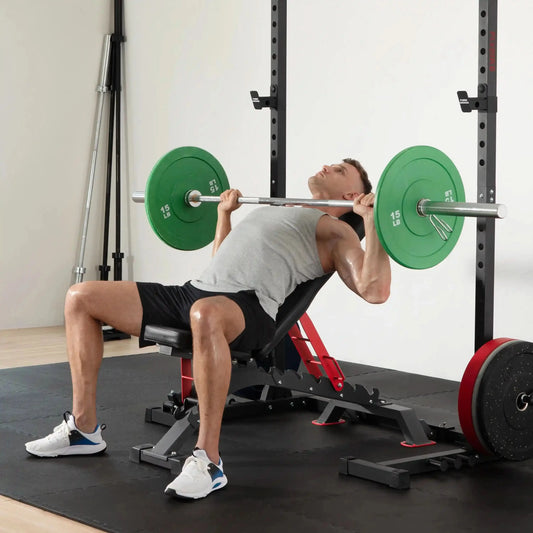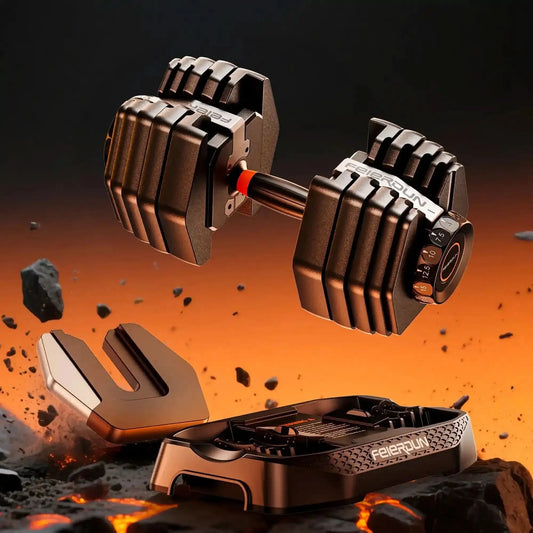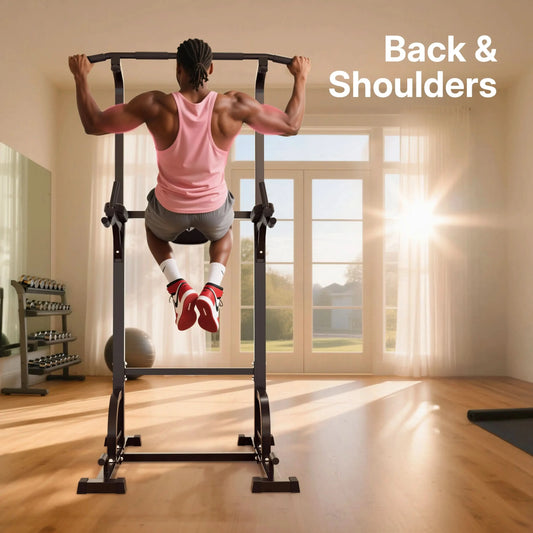What Is the Bench Press?
How to Warm Up for Bench Press
- 5–10 minutes of light cardio (e.g. brisk walking, cycling).
- Dynamic mobility: arm circles, shoulder dislocations, band pull-aparts.
- Scapular retraction drills with a band
- External rotation with light dumbbells or bands
- Push-up holds or plank holds to grip the core
- Using the empty bar or light dumbbells: 8–10 reps
- Gradually increase weight over 2–3 sets until you reach the working load
How to Bench Press: Step-by-Step Guide
Barbell Bench Press
Setup & Position
- Place a weight bench in a rack with safety pins set to catch the bar if needed.
- Lie down so your eyes are beneath the bar. Retract your shoulder blades and press them into the bench.
- Keep a slight natural arch in your lower back, tight glutes, and engaged upper back.
- Plant your feet firmly on the floor, about shoulder-width apart, and engage your legs.
Grip & Unrack
- Grip slightly wider than shoulder width with thumbs wrapped around the bar.
- Unrack the bar, keeping your arms extended above your chest.
Lowering the Bar
- Inhale, brace your core, and lower the bar under control to mid-chest.
- Keep elbows at roughly a 45° angle to your torso and forearms vertical.
- Avoid bouncing the bar off your chest.
Pressing Up
- Exhale or hold your breath as you push the bar back up.
- Drive through your feet and glutes for stability and power.
- Press along a slight arc so the bar ends above your shoulders.
- Lock out without hyperextending elbows.
Racking the Bar
- Guide the bar back carefully onto the hooks while maintaining tightness and control.
Dumbbell Bench Press
Setup & Position
- Lie on a weight bench with dumbbells resting near your thighs. Use leg drive to bring them to chest level.
- Retract shoulder blades, maintain a slight back arch, and keep glutes tight.
Grip & Starting Position
- Hold dumbbells with a neutral grip (palms facing each other) or slightly rotated inward.
- Keep wrists straight and elbows under wrists.
Lowering & Pressing
- Lower dumbbells along the chest’s natural line, keeping elbows at about 45° from the body.
- Press upward while exhaling or bracing the core.
- Don’t lock elbows rigidly; maintain control throughout the movement.
Benefits
Dumbbells allow a greater range of motion and help correct left-right strength imbalances.
How Much Weight Should You Bench?
- Start with the empty bar (usually 45 lbs / 20 kg) or light dumbbells to test your baseline.
- Use progressive overload: increase weight only when you can complete all reps with perfect form.
- Begin with 8–12 reps for hypertrophy or 4–6 reps for strength focus.
- Avoid ego lifting: if form breaks down, reduce weight.
- Every 4–6 weeks, reassess your max (e.g., using 1–3 rep max protocols) and reset your training weights accordingly.
Bench Press Mistakes That Kill Your Progress (and How to Fix Them)
Using your chest as a trampoline might move the weight faster, but it robs your muscles of real work and risks bruising or injury.
Fix it: Lower the bar under control until it lightly touches your chest. Think of “pausing” for a split second before pressing it back up.
Letting Your Elbows Flare Out
Elbows flared wide put your shoulders in a weak, vulnerable spot. Over time, this is one of the fastest ways to irritate your joints.
Fix it: Keep your elbows tucked at about a 45-degree angle to your torso. This keeps your shoulders safe and your chest fully engaged.
Feet Floating or Shuffling
Your legs are part of the lift. If your feet are dancing around or barely touching the floor, you’re giving up valuable stability and power.
Fix it: Plant your feet firmly on the ground, slightly behind your knees, and push through them as you press. Stable feet = stronger lift.
Half Reps and Short Range of Motion
Stopping halfway might let you load more weight, but it cheats your chest and triceps out of full development.
Fix it: Lower the bar all the way to your chest, then lock out fully at the top. A complete rep does more for strength and muscle than two half reps.
Loose Shoulder Position
A relaxed upper back makes the bar harder to control and shifts stress onto the shoulders.
Fix it: Retract and squeeze your shoulder blades into the bench before you unrack the bar. Stay tight through every rep.
Ignoring Warm-Up Sets
Jumping straight into heavy weights is a shortcut to poor form and unnecessary strain.
Fix it: Start with lighter sets to groove your form, get your blood flowing, and prepare your joints for the load.
Variations of the Bench Press
- Incline Bench Press – targets the upper chest.
- Decline Bench Press – focuses on the lower chest.
- Close-Grip Bench Press – emphasizes the triceps.
- Paused Bench Press – pause at the bottom to strengthen the deep position.
- Partial Range Presses (Board or Pin Press) – improve lockout strength.
- Dumbbell Variants and Flyes – help address weak points and provide accessory work.
Bench Press Safety Tips
- Always use a rack with safety pins or have a spotter for heavy lifts.
- Warm up properly before lifting.
- Increase weight gradually and avoid rushing progress.
- Listen to your body and stop if you feel sharp pain.
- Wrap your thumbs around the bar for a secure grip.
- Maintain control, keep your core braced, glutes tight, and shoulder blades retracted.
- Breathe properly to manage intra-abdominal pressure.
Expert Tips for Serious Bench Gains
- Use your legs for power: Drive through your feet and engage your glutes and quads to add stability and strength to every rep.
- Activate your lats: Imagine slightly twisting or “bending” the bar apart to tighten your back and create a stronger pressing base.
- Increase weight gradually: Add small amounts of weight over time to build consistent strength without sacrificing form.
- Play with tempo: Mix slow descents with explosive pushes to build better control and improve overall pressing power.
- Strengthen support muscles: Add triceps, shoulder, and upper-back work to improve pressing mechanics and reduce injury risk.
- Cycle your training: Plan phases with deload weeks and vary intensity and volume to keep progress steady and avoid burnout.
- Track your form: Record your sets or work with a coach to catch small mistakes before they turn into bad habits.
- Change your grip: Alternate between narrow, medium, and wide grips to target different parts of the chest and triceps.
Conclusion
Frequently Asked Questions
Should I touch the bar to my chest every rep?
How often should I bench press per week?
Is arching my back okay?
Which is better: barbell or dumbbell bench?












